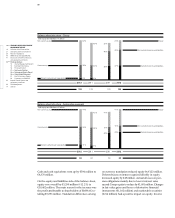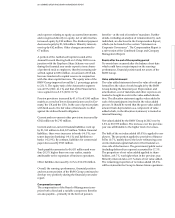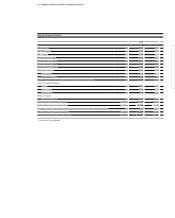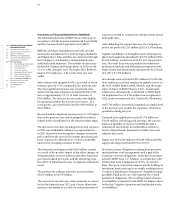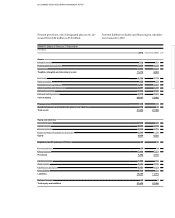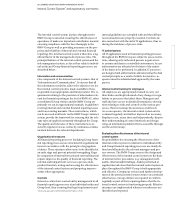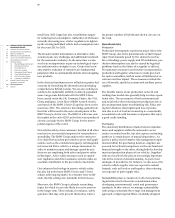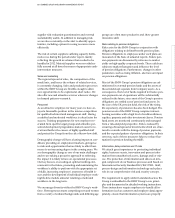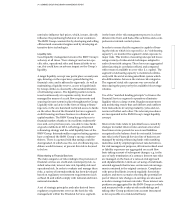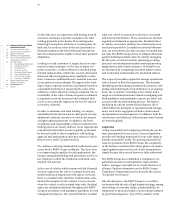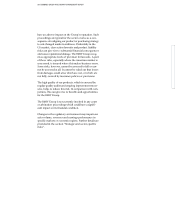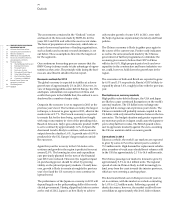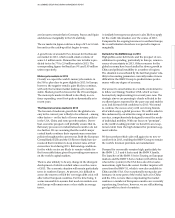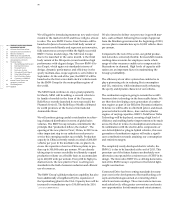BMW 2012 Annual Report Download - page 67
Download and view the complete annual report
Please find page 67 of the 2012 BMW annual report below. You can navigate through the pages in the report by either clicking on the pages listed below, or by using the keyword search tool below to find specific information within the annual report.
67 COMBINED GROUP AND COMPANY MANAGEMENT REPORT
The risk management system is tested regularly by the
Internal Audit. By regularly sharing experiences with
other companies, the BMW Group ensures that new in-
sights flow into the risk management system, thus con-
tributing to continual improvement. Regular basic and
further training as well as information events are invalu-
able ways of preparing people for new or additional re-
quirements with regard to the processes in which they
are involved.
Managing the business on a sustainable basis is a core
corporate strategy (see “Sustainability” section in the
Combined Group and Company Management Report).
Opportunities and risks related to sustainability issues
are discussed in a sustainability committee. Strategic
options and measures open to the BMW Group are put
forward to the
Sustainability Board, to which all mem-
bers of the Board
of Management belong. The emer-
gence of new risks is also monitored closely throughout
the group-wide risk network. The close ties between
steering and
sustainability committees ensure that risk
and sustain ability
management are closely coordinated.
The principal risk factors facing the BMW Group are de-
scribed below. Additional disclosures on risks relating
to financial instruments are provided in note 41 of the
Group Financial Statements.
Political and global economic risks
The ever-growing complexity and intensity of world-
wide competition is constantly increasing the danger of
incalculable chain reactions and their consequences.
General anxiety regarding the stability of the finance
system and further developments in the sovereign debt
crisis currently constitute risk factors for business per-
formance. The slow-down of economic momentum in
China, political instability in the Middle East and parts
of Asia as well as market regulations in various coun-
tries pose further risks.
The escalation of political tension, terrorist activities,
natural disasters or possible pandemics could all have a
negative impact on the world economy and interna-
tional capital markets that can lead to a scarcity of raw
materials and the possible breakdown of material or
parts deliveries. The BMW Group counters these risks
primarily by internationalising its purchasing, sales and
production structures in order to reduce the potential
impact of risk exposures in individual countries.
Strategic and sector-specific risks
The car manufacturing industry worldwide is faced with
the constant challenge of having to reduce fuel
con-
sumption and emissions and raise safety standards at
the same time. These requirements are increasingly
accompanied by rules governing individual mobility in
metropolitan areas. Changing regulations and rising
fuel and energy prices also influence customer behaviour.
One of the main risks the industry faces is the possible
threat of short-term tightening of laws and regulations
that can trigger the requirement for significantly higher
levels of investment. In some cases, changes in customer
behaviour are not only brought on by new regulations,
but also through changes of opinion,
values and envi-
ronmental issues. Among other factors, global climate
change is having an effect on legislation, regulations
and consumer behaviour. In order to meet structural
changes in the demand for individual mobility that no
longer necessarily means actually owning a vehicle, we
are offering corresponding mobility services, such as
the DriveNow car-sharing model.
With its Efficient Dynamics concept, the BMW Group
has a pioneering role in reducing both fuel consump-
tion and emissions and fulfilling legal rules and require-
ments at the same time. In addition, the BMW Group is
investing in the development of sustainable drive tech-
nologies and materials, with the aim of providing highly
efficient vehicles for individual mobility in the premium
segment well into the future.
Risks emanating from statutory requirements to take
back and recycle end-of-life vehicles are minimised
by ensuring that “designing for recycling” is fully con-
sidered during the product development stage. All ef-
forts are taken to ensure that the raw materials gained
from recycling end-of-life vehicles can be reused in the
production process. Statutory risks stemming from
vehicle recycling in various markets are minimised by
means of a specialised in-house team working in con-
junction with regional managers.
Medium- and long-term targets have already been put
in place in Europe, North America, Japan, China and
other countries to reduce fuel consumption and CO2
emissions. Europe has set a target of achieving an aver-
age of 130 g CO2 / km for all new vehicles by 2015. The
EU Regulation defines rules for CO2 emissions based on
the weight of each particular vehicle. For the BMW Group
this means a target of under 140
g CO2 / km
per vehicle.
In
the USA fuel economy targets have now been defined
up to the year 2025. Beginning with a gradual reduction
for 2012 models, the new car fleets of all manufac-
turers
are to achieve an average emission value of 250 g
CO
2
/ mile (155 g CO
2
/ km) by model year 2016 and
an average value of 163 g CO
2
/ mile (101 g CO
2
/ km) by



